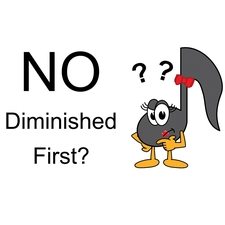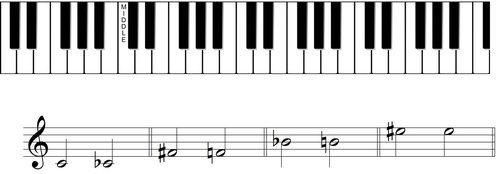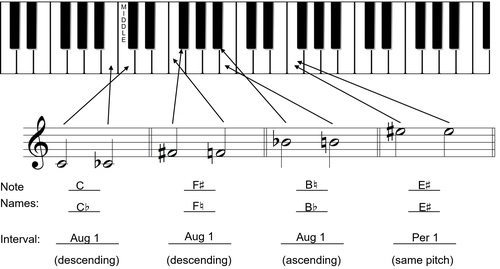No Diminished First

No Diminished First
What is the smallest written interval possible in traditional theory? While most people will say that it is the diminished first, there is no such interval as a diminished first.
That is right - there is no such interval as a diminished first!
In this blog, we will explore why the smallest interval is always a Perfect 1.
We will also learn why a Perfect 1 will always become a half step (semitone) "bigger" to become an Augmented 1 and why it will never become a half step (semitone) "smaller" to a diminished first.
What is a Simple Interval?
The first thing we need to understand is what exactly is a Simple Interval. A Simple Interval is any interval between a Perfect 1 and a Perfect 8 (inclusive). That means - any interval from a Perfect 1 (the smallest interval) to a Perfect 8 (the largest simple interval).
To name an interval, follow these steps:
- Identify the name of the lowest (lower) note and the name of the highest (upper) note.
- Identify the interval number. The smallest simple interval number will always be a "1" (a first).
- Identify the quality of the interval (Perfect, Major, minor, Augmented or diminished) based on the Major Key of the lowest (lower) note.
These steps are taught in the Basic Rudiments Workbook starting on Page 60. However, Augmented and diminished intervals are not introduced until page 73 in the Intermediate Rudiments Workbook.
What is the Smallest Interval?
The "smallest" interval (in traditional theory) is the Perfect 1. You cannot get any closer to a pitch than repeating that pitch using the same letter name.
However, intervals can have direction. Time to have fun with Intervals!
- Play the following intervals on your instrument.
- Identify the direction of the pitch that you "hear": ascending (step up), descending (step down) or same pitch.
- Draw a line from each note on the staff to the corresponding key on the keyboard.
- Name the intervals.

All the intervals are firsts. If you identified any of them as a diminished first, you will have made a boo-boo.
Why is there No Diminished First?
So why is there no diminished first? Simple - read step #3 again. That's right, the quality of the interval is based on the Major Key of the lowest note. Not the first note. The LOWEST note.
Let's try this again. This time, name the notes (lower note first), and then name the intervals.

Before I show you the answers, I want you to double-check - did you write the note with the lowest PITCH as the Lower Note (on the lower line) or did you write the "first note" as the Lower Note?
Even though the direction of the pitch may descend (or ascend) when you play the interval, "interval direction" doesn't count when naming intervals!
No Diminished First - Direction Doesn't Matter!
When naming an interval, it can be played ascending, descending, at the same time, or standing on your head - it doesn't matter how it is played or in what order the notes are written! What matters is the distance from the lowest pitched note to the highest pitched note, and the quality based on the Major Scale of the lowest note.
So, an Augmented 1st can descend, it can ascend and it can be played harmonically. But it will never be called a diminished first as, (repeat after me) there is no diminished first!
Here are the answers.

Again... What is the Smallest Interval?
So, let's ask this question again - what is the smallest interval possible in traditional theory?
That is correct! (Yay for You!) The "smallest" interval (in traditional theory) is the Perfect 1. You cannot get any closer to a pitch than repeating that pitch using the same letter name.
However, intervals can have direction. But direction doesn't matter when naming intervals, doesn't it! Isn't that a neat thing to know?!

Teach Intervals Online Course is a Teacher Training with 6 Video Sessions plus downloadable worksheets on the What, Where & Why Secrets for Teaching Intervals.
To help you even more we've created FREE RESOURCES for you to use as learning tools and building blocks in your musical adventure.
Keep on Learning... With a Smile and a Song!
Shelagh McKibbon-U'Ren


Congratulations: well taught!
Makes “perfect” sense.
Good post, thanks.
I have seen British music theory materials which teach the concept of a diminished unison. Their argument is bolstered when you consider inversions: diminished intervals invert into augmented and vice versa. So the augmented unison–C to C#–(they say) inverts to a diminished octave (C# to C) and a ‘diminished unison’–C to Cb–(they say) inverts to an augmented octave (Cb to C). Of course, if you discount compound intervals then this becomes Cb to C (starting with the lowest note) inverts to C to Cb, which is a diminished octave. I, personally, don’t like the concept of a diminished unison for exactly the reasons Shelagh gives: how do you make two notes closer than a unison? You can’t get any closer than a unison!
When identifying an interval, it does not matter which note is written first. An interval is identified by naming the LOWEST PITCHED note and the HIGHEST PITCHED note. This has nothing to do with direction of sound. People who think there is a diminished unison (dim 1) think it is diminished because (for example) they are playing C natural to C flat. They see that direction as descending and assume that it is diminished because the pitch is going “down”. However, the LOWEST PITCHED note is C flat and the HIGHEST PITCHED note is C natural. That is Augmented. An Augmented 1st always inverts to a diminished 8 (LOWEST PITCHED note – C natural, HIGHEST PITCHED note – C flat = diminished 8).
If you tried to invert C to C flat (incorrectly calling it a diminished 1st simply because it is descending), the inversion would still be Lowest Pitched note – C to HIGHEST PITCHED note – C flat. (If you wrote C flat UP to C, you did not invert as your lowest pitched note in the original interval is C flat!)
An AUGMENTED OCTAVE is a Compound Interval. It is bigger than a Perfect Octave. An Augmented Octave inverts to a Diminished Octave.